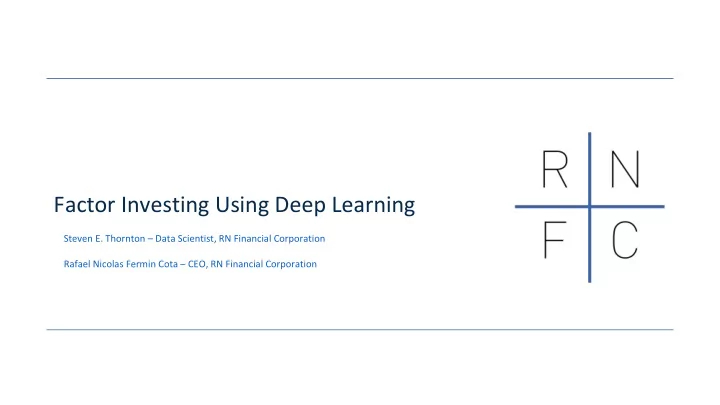

Factor Investing Using Deep Learning Steven E. Thornton – Data Scientist, RN Financial Corporation Rafael Nicolas Fermin Cota – CEO, RN Financial Corporation
About RN Financial Research RN Financial Research Centre is a financial research company focused on developing high-performance software for generating clean data. We use data science for quantitative analysis on equities by leveraging fundamental company data. 1
Part One - Data “Data is the new Oil” 2
Data quality Quality of data is paramount Homogenized Free of biases Trustworthy source Data needs to be clean Implementable Right format Up-to-date 3
Data we use Descriptive Pricing Fundamentals Corporate Action 4
Research process 1. Obtain data 2. Clean data 3. Linking with other datasets 4. Generating aggregations or new features 5. Storing in a database 5
Issues we overcame through our experience 1. Extraction is slow 2. Messy 3. Inflexible 4. Difficult to compare among analysts 5. Cleaning is slow 6
Domain expertise We’ve experienced the headaches of data cleaning We’re not just a data vendor Constantly refining our process We use our data 7
Software and hardware Software Retrieve data from vendors • Distributed analytical database • High performance C++ for data cleaning • Easy to add new factors • Scalable • Hardware High-performance hardware managed by experts • Storage systems • 8
Skill management Developer Financial Expert 9
Part Two- Case Study Applying Deep Learning for Fundamental-Based Signal Generation 10
Objective Build a model that forecasts if stock ABC will outperform stock XYZ over the next year. 11
Optimized using GPUs 1. Model Training 2. Portfolio Construction 12
Data 1,233 Factors Momentum • Value • Growth • Technical • Sentiment • Investable Universe Market cap of at least $1B USD • Price of at least $5.00 • Sector Filters • Corporate action filters • 13
Investable universe 14
Model overview 1. Rank factor values on each day 2. Generate all pairs of stocks on each day 3. Predict if stock ABC will outperform stock XYZ over the next year 4. Generate a probability matrix 5. Compute the probability of each stock outperforming/underperforming all other stocks 6. Long the top 50 stocks each day, short the bottom 50 7. Apply a portfolio construction algorithm each day to determine stock weights 8. Layer portfolios each day 15
Step 1: Rank factor values on each day 16
Step 2: Generate all pairs of stocks on each day 17
Step 3: Predict if stock ABC will outperform stock XYZ over the next year Classification Model • Training set contains 1 day every 3 months (expanding) • If we don’t use enough data, our model may “memorize” the best/worst stocks 18
Step 4: Generate a probability matrix A matrix that contains the predicted probability of stock j outperforming stock i over the next year: P = P i,j = Pr( X i ≤ X j ) 19
Step 5: Probability of each stock outperforming/underperforming all other stocks Probability of stock i outperforming all other stocks: Probability of stock i underperforming all other stocks: N N Y Y Pr( X i ≤ X 1 & X i ≤ X 2 & · · · & X i ≤ X N ) = Pr( X i ≤ X j ) Pr( X i > X 1 & X i > X 2 & · · · & X i > X N ) = 1 − Pr( X i ≤ X j ) j =1 j =1 j 6 = i j 6 = i Stock Log Probability of Best Log Probability of Worst Stock 1 -478.86101 -1311.6859 Stock 2 -1033.0009 -605.94667 Stock 3 -740.48224 -841.6922 Stock 4 -868.96107 -713.01704 Stock 5 -666.08427 -911.40809 20
Step 6: Long the top 50 stocks each day, short the bottom 50 21
Step 6: Long the top 50 stocks each day, short the bottom 50 22
Step 7: Portfolio construction algorithm each day to determine stock weights Overview of Algorithm 1. Cluster the portfolios using hierarchical clustering (single linkage) 2. Sort based on the clustering 3. Split portfolios in half, weighting both halves by their inverse portfolio volatility López de Prado, Marcos, Building Diversified Portfolios that Outperform Out-of-Sample (May 23, 2016). Journal of Portfolio Management, 2016, Forthcoming. 23
Step 7: Portfolio construction algorithm each day to determine stock weights 24
Step 7: Portfolio construction algorithm each day to determine stock weights 25
Step 7: Portfolio construction algorithm each day to determine stock weights 26
Step 7: Portfolio construction algorithm each day to determine stock weights 27
Step 8: Layer portfolios each day 28
Questions?
Recommend
More recommend